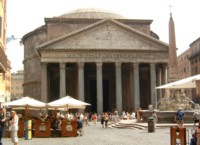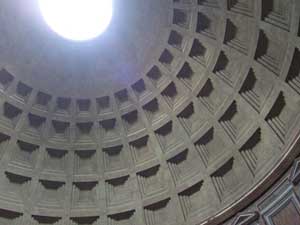The Pantheon is one of the greatest of all Rome’s sights and is Italy Heaven’s personal favourite. One of the most beautiful and evocative buildings in the world, it has stood through centuries of change.
The interior is simply breathtaking and awe-inspiring, exuding a sense of peace and an air of calm, despite the tourists flocking in and out through the great doorway.
For nearly two thousand years this building has stood in this spot, while around it battles have been fought and lost, carts and litters have given way to cars and scooters. It’s fascinating to stand in this oasis of calm, and to reflect on the changes that have taken place in the noisy city outside. Whatever else has changed, the Pantheon is one sight that would be thoroughly familiar to an ancient Roman transported into the twenty-first century.

The word ‘Pantheon’ signifies all the deities, and the building originated as a temple to twelve of the most important Roman gods. The Pantheon was built in about 125AD during the reign of the Emperor Hadrian. The temple replaced an earlier building constructed by Agrippa (commemorated in the inscription on the portico). This feat of engineering owes its survival to the fact that it was dedicated as a Christian church in 609 after being presented to the Pope. The bronze panels from the portico and the bronze roof were requisitioned by the Emperor Constans II and by Pope Urban VIII (for use in St. Peter’s), but otherwise Emperors and Popes alike kept the building in good condition befitting its religious status. In later centuries the Pantheon became the final resting place of artists and kings, including Raphael and Vittorio Emmanuele II, the first king of united Italy.
The sense of harmony inside the Pantheon is partly due to its perfect proportions; the dome’s diameter is equal to its height from the floor, creating the potential for a perfect spere. A 9-metre hole, the oculus, lets in the daylight, and it’s easy to see the spiritual significance that this link to the heavens would have possessed. When it rains, water cascades through the roof and slowly drains from the floor.
Nowadays the Pantheon is still a consecrated church and used for occasional services, concerts and poetry readings. It’s free to enter, and is usually open during daylight hours.
Outside, in Piazza della Rotonda, as well as a fountain sporting one of Rome’s trophy obelisks, there are several restaurants and bars (not cheap, but worth it for the view) and even a Macdonalds. The bus and tram stops of Largo Argentina are a couple of minutes walk away, Spagna metro station is about fifteen minutes on foot. The Pantheon is in the heart of the Centro Storico, and fits in well to a scenic walk.
On this site
